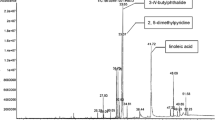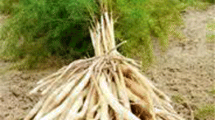Abstract
Botanical resources with great diversity in medicinal and aromatic plants are a rich and reliable source for finding insect repellents of plant origin, which are widely popular among today’s consumers. Although some herbal-based repellents have been proven comparable to or even better than synthetics, commercially available natural repellents generally tend to be expensive, with short-lived effectiveness. This critical flaw leads to ongoing research for new and effective repellents, which provide longer protection against vector and nuisance-biting insects, while remaining safe, user friendly, and reasonably priced. This study aimed to evaluate the repellent activity of plant-derived products against the primary dengue vector, Aedes aegypti, by following the human bait technique of World Health Organization guidelines. Preliminary laboratory screening tests for repellency of 33 plant species clearly demonstrated Angelica sinensis as the most effective repellent from each kind of extracted product, with its essential oil and ethanolic extract having median complete protection times of 7.0 h (6.0–7.5) and 2.5 h (2.0–2.5), respectively. Due to its low yield (0.02 %), pungent smell, and little cause of irritation, A. sinensis essential oil did not qualify as a candidate for further repellent assessment. However, subsequent extractions of A. sinensis with different organic solvents of increasing polarity provided four extractants with varying degrees of repellency against A. aegypti. The hexane extract of A. sinensis provided excellent repellency, with a median complete protection time of 7.5 h (6.5–8.5), which was longer than that of ethanol (2.5, 2.0–2.5 h), acetone (1.75, 0.5–2.5 h), and methanol extracts (0.5, 0–1.0 h). By being the most effective product, A. sinensis hexane extract gave significant protection comparable to that of its essential oil and the standard synthetic repellent, N,N-diethyl-3-methylbenzamide (DEET: 6.25, 5.0–6.5 h). Qualitative gas chromatography/mass spectrometry analysis demonstrated the presence of phthalides and phthalates, including 3-N-butylphthalide, butylidenephthalide, ligustilide, and di-iso-octyl phthalate, as the principal constituents in A. sinensis products. The success of A. sinensis products, particularly that of hexane extract, has proved their potential as bioactive candidates in the next step for developing and producing alternative natural repellents with commercial aspirations.

Similar content being viewed by others
References
Amer A, Mehlhorn H (2006) Repellency effect of forty-one essential oils against Aedes, Anopheles, and Culex mosquitoes. Parasitol Res 99:478–490
Beck JJ, Chou SC (2007) The structural diversity of phthalides from the Apiaceae. J Nat Prod 70:891–900
Berenbaum M (1985) Allelochemical interactions in plants. Rec Adv Phytochem 19:139–169
Brady DA, Curtis CF (1993) Assessment of the efficacy of Quwenling as a mosquito repellent. Phytother Res 7:17–20
Chavasse DC, Yap HH (1997) Chemical methods for the control of vector and pests of public health importance. WHO/CTD/WHOPES/97.2. WHO, Geneva
Choochote W, Kanjanapothi D, Panthong A et al (1999) Larvicidal, adulticidal and repellent effects of Kaempferia galanga. Southeast Asian J Trop Med Public Health 30:470–476
Choochote W, Chaithong U, Kamsuk K et al (2007) Repellent activity of selected essential oils against Aedes aegypti. Fitoterapia 78:359–364
Evergetis E, Michaelakis A, Haroutounian SA (2012) Essential oils of Umbelliferae (Apiaceae) family taxa as emerging potent agents for mosquito control. In: Soloneski S (ed) Integrated pest management and pest control - current and future tactics. InTech, China, pp 613–638
FAO (1995) Basic principles of steam distillation. FAOWeb. http://www.fao.org/docrep/V5350e/V5350e13.htm. Accessed 26 Dec 2014
Farag M, Ahmed MH, Yousef H, Abdel-Rahman AA (2011) Repellent and insecticidal activities of Melia azedarach L. against cotton leafworm Spodoptera littoralis (Boisd.). Z Naturforsch C 66:129–135
Foster BC, Arnason JT, Briggs CJ (2005) Natural health products and drug disposition. Annu Rev Pharmacol Toxicol 45:203–226
Fradin MS (1998) Mosquitoes and mosquito repellents: a clinician’s guide. Ann Intern Med 128:931–940
Fradin MS, Day JF (2002) Comparative efficacy of insect repellents against mosquito bites. N Engl J Med 347:13–18
Frances SP, Klein TA, Hildebrandt DW et al (1996) Laboratory and field evaluation of deet, CIC-4, and AI3-37220 against Anopheles dirus (Diptera: Culicidae) in Thailand. J Med Entomol 33:511–515
Gillij YG, Gleiser RM, Zygadlo JA (2008) Mosquito repellent activity of essential oils of aromatic plants growing in Argentina. Bioresour Technol 99:2507–2515
Goodyer LI, Croft AM, Frances SP et al (2010) Expert review of the evidence base for arthropod bite avoidance. J Travel Med 17:1708–8305
Harborne JB (1984) Phytochemical methods: A guide to modern technique of plant analysis. Chapman and Hall, London
Hazarika S, Dhiman S, Rabha B, Bhola RK, Singh L (2012) Repellent activity of some essential oils against Simulium species in India. J Insect Sci 12(5):1–9. doi:10.1673/031.012.0501
Heba Y, El-Lakwah SF, EL Sayed YA (2013) Insecticidal activity of linoleic acid against Spodoptera littoralis (Boisd.). Egypt J Agric Res 91:573–580
Huang KC (1993) The pharmacology of Chinese herbs. CRC Press, Boca Raton
Hummelbrunner LA, Isman MB (2001) Acute, sublethal, antifeedant, and synergistic effects of monoterpenoid essential oil compounds on the tobacco cutworm, Spodoptera litura (Lep. Noctuidae). J Agric Food Chem 49:715–720
Kamalakannan S, Murugan K, Barnard DR (2011) Toxicity of Acalypha indica (Euphorbiaceae) and Achyranthes aspera (Amaranthaceae) leaf extracts to Aedes aegypti (Diptera: Culicidae). J Asia-Pac Entomol 14:41–45
Keys JD (1976) Chinese herbs (their botany, chemistry, and pharmacodynamics). Charles E. Tuttle Company, Inc., Tokyo
Kweka EJ, Munga S, Mahande AM et al (2012) Protective efficacy of menthol propylene glycol carbonate compared to N, N-diethyl-methylbenzamide against mosquito bites in Northern Tanzania. Parasit Vectors 5:189
Labunska I, Santillo D (2004) Environmental and human health concerns relating to diethyl phthalate (DEP), a common ingredient in cosmetics and other personal care products. GreenpeaceWeb. http://www.greenpeace.to/publications/dep_2004.pdf. Accessed 20 Dec 2014
Limsuwan S, Rongsriyam Y, Kerdpibule V, Apiwathnasorn C, Chiang GL, Cheong WH (1987) Rearing techniques for mosquitoes. In: Sucharit S, Supavej S (eds) Practical entomology. Malaria and Filariasis, 1st edn. Museum and Reference Centre, Faculty of Tropical Medicine, Mahidol University, Bangkok
Lloyd AM, Farooq M, Diclaro JW, Kline DL, Estep AS (2013) Field evaluation of commercial off-the-shelf spatial repellents against the Asian tiger mosquito, Aedes albopictus (Skuse), and the potential for use during deployment. US Army Med Dep J Apr-Jun:80–86
Lupi E, Hatz C, Schlagenhauf P (2013) The efficacy of repellents against Aedes, Anopheles, Culex and Ixodes spp. - A literature review. Travel Med Infect Dis 11:374–411
Lust JB (1974) The herb book. Benedict Lust Publications, California
Maia MF, Moore SJ (2011) Plant-based insect repellents: a review of their efficacy, development and testing. Malar J 10(Suppl 1):S11
Mandal S (2011) Repellent activity of Eucalyptus and Azadirachta indica seed oil against the filarial mosquito Culex quinquefasciatus Say (Diptera: Culicidae) in India. Asian Pac J Trop Biomed 1:S109–S112
McCabe ET, Barthel WF, Gertler SI, Hall SD (1957) Insect repellents. III N, N-Diethylamides. J Org Chem 19:493–498
Mehmood F, Manzoor F, Khan ZUD (2012) Evaluation of toxicity and repellency of essential oils of family Rutaceae against black ants (Lasius niger) in Pakistan. Asian J Chem 24:3087–3090
Mehta RM (2002) Pharmaceutics–I. Vallabh Prakashan, Delhi
Miguel MG (2010) Antioxidant and anti-inflammatory activities of essential oils: a short review. Molecules 15:9252–9287
Nerio LS, Olivero-Verbel J, Stashenko E (2010) Repellent activity of essential oils: a review. Bioresour Technol 101:372–378
Newman A (2013) How to make essential oils. Herbs-InfoWeb. http://www.herbs-info.com/how-to-make-essential-oils.html. Accessed 26 Dec 2014
Nilsson E, Bengtsson G (2004) Endogenous free fatty acids repel and attract Collembola. J Chem Ecol 30:1431–1443
Novak RJ, Gerberg EJ (2005) Natural-based repellent products: efficacy for military and general public uses. J Am Mosq Control Assoc 21:7–11
Osimitz TG, Murphy JV (1997) Neurological effects associated with use of the insect repellent N, N-diethyl-m-toluamide (DEET). J Toxicol Clin Toxicol 35:435–441
Panneerselvam C, Murugan K (2013) Adulticidal, repellent, and ovicidal properties of indigenous plant extracts against the malarial vector, Anopheles stephensi (Diptera: Culicidae). Parasitol Res 112:679–692
Pongboonrod S (1976) Thai medicinal plants. Kasambanakit Press, Bangkok
Qui H, Jun HW, John WM (1998) Pharmacokinetics, formulation, and safety of insect repellent N, N-diethyl-3-methylbenzamide (DEET): a review. J Am Mosq Control Assoc 14:12–27
Rehman JU, Ali A, Khan IA (2014) Plant based products: use and development as repellents against mosquitoes: a review. Fitoterapia 95:65–74
Reutemann P, Ehrlich A (2008) Neem oil: an herbal therapy for alopecia causes dermatitis. Dermatitis 19:E12–E15
Sanghong R, Junkum A, Choochote W et al (2014) Repellency screening of herbal products against the dengue fever vector, Aedes aegypti (Diptera: Culicidae). Chiang Mai Med J 53:53–61
Seyoum A, Pålsson K, Kung'a S et al (2002) Traditional use of mosquito-repellent plants in western Kenya and their evaluation in semi-field experimental huts against Anopheles gambiae: ethnobotanical studies and application by thermal expulsion and direct burning. Trans R Soc Trop Med Hyg 96:225–231
Singh SP, Mittal PK (2013) Mosquito repellent and oviposition deterrent activities of Solanum nigrum seed extract against malaria vector Anopheles stephensi. OIIRJ 3:326–333
Smitinand T (1980) Thai plant names (botanical names – vernacular names). Royal Forest Department, Bangkok
Strickman D, Frances SP, Debboun M (2009) Chapter 8: put on something natural. Prevention of bugs, bites, stings and disease. Oxford University Press, New York
Tang Y, Zhu M, Yu S et al (2010) Identification and comparative quantification of bio-active phthalides in essential oils from si-wu-tang, fo-shou-san, radix angelica and rhizoma chuanxiong. Molecules 15:341–351
Trigg JK (1996) Evaluation of a eucalyptus based repellent against Anopheles spp. in Tanzania. J Am Mosq Control Assoc 12:243–246
Tripathi AK, Upadhyay S, Bhuiyan M, Bhattacharya PR (2009) A review on prospects of essential oils as biopesticides in insect-pest management. J Pharmacog Phytother 1:52–63
Trumble JT (2002) Caveat emptor: safety considerations for natural products used in arthropod control. Am Entomol 48:7–13
Tsukamoto T, Ishikawa Y, Miyazawa M (2005) Larvicidal and adulticidal activity of alkylphthalide derivatives from rhizome of Cnidium officinale against Drosophila melanogaster. J Agric Food Chem 53:5549–5553
Tuetun B, Choochote W, Rattanachanpichai E et al (2004) Mosquito repellency of the seeds of celery (Apium graveolens L.). Ann Trop Med Parasitol 98:407–417
Tuetun B, Choochote W, Pongpaibul Y et al (2009) Field evaluation of G10, a celery (Apium graveolens)-based topical repellent, against mosquitoes (Diptera: Culicidae) in Chiang Mai province, northern Thailand. Parasitol Res 104:515–521
US EPA (2000) Dimethyl phthalate. Air ToxicWeb. http://www.epa.gov/ttnatw01/hlthef/dimet-ph.html. Accessed 26 Dec 2014
Wandscheer CB, Duque JE, da Silva MA et al (2004) Larvicidal action of ethanolic extracts from fruit endocarps of Melia azedarach and Azadirachta indica against the dengue mosquito Aedes aegypti. Toxicon 44:829–835
Wedge DE, Klun JA, Tabanca N et al (2009) Bioactivity-guided fractionation and GC/MS fingerprinting of Angelica sinensis and Angelica archangelica root components for antifungal and mosquito deterrent activity. J Agric Food Chem 57:464–470
WHO (1996) Report of the WHO informal consultation on the evaluation and testing of insecticides. CTD/WHOPES/IC/96.1, Control of Tropical Diseases Division. WHO, Geneva
WHO (2003) Diethyl phthalate, Concise International Chemical Assessment Document 52. WHOWeb. http://www.who.int/ipcs/publications/cicad/en/cicad52.pdf. Accessed 20 Dec 2014
Acknowledgments
The authors are grateful to the Faculty of Medicine Research Fund and Diamond Research Grant of the Faculty of Medicine, Chiang Mai University (CMU), Thailand, for their financial support. Thanks are also due to Mr. James Franklin Maxwell, a botanist at the Herbarium, Department of Biology, Faculty of Science, CMU and Miss Wannaree Charoensup, a scientist at the Department of Pharmaceutical Science, Faculty of Pharmacy, CMU, Chiang Mai province, Thailand, for their assistance with the taxonomic identification of plant samples.
Ethical approval
Ethical approval for this project is in accordance with protocol PAR-2556-01588 of the Research Ethics Committee, Faculty of Medicine, Chiang Mai University.
Conflict of interest
The authors declare that they have no conflict of interest.
Author information
Authors and Affiliations
Corresponding author
Rights and permissions
About this article
Cite this article
Champakaew, D., Junkum, A., Chaithong, U. et al. Angelica sinensis (Umbelliferae) with proven repellent properties against Aedes aegypti, the primary dengue fever vector in Thailand. Parasitol Res 114, 2187–2198 (2015). https://doi.org/10.1007/s00436-015-4409-z
Received:
Accepted:
Published:
Issue Date:
DOI: https://doi.org/10.1007/s00436-015-4409-z




